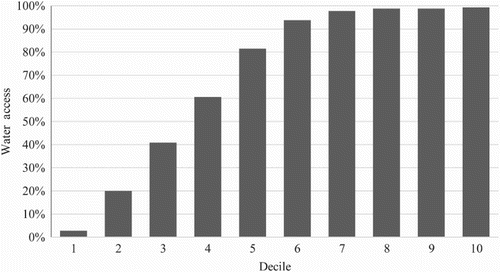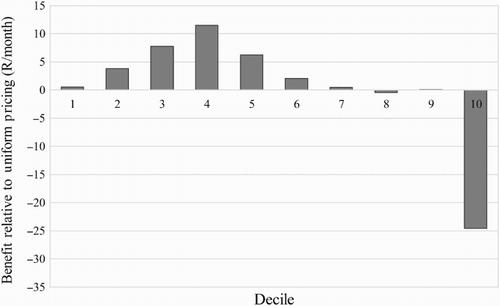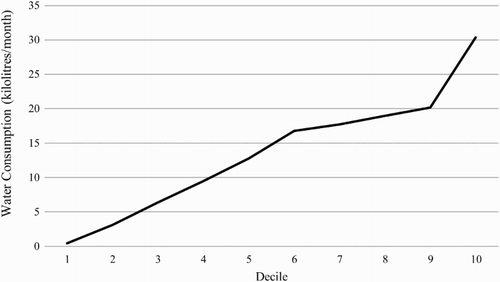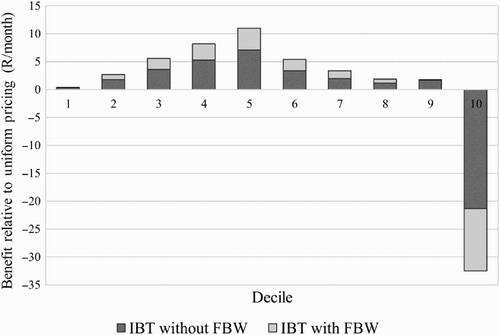Abstract
The primary goals of water pricing are to ensure that water is used sparingly and that sufficient revenues are earned. Pricing can, however, also be used to address equity concerns. One such policy often applied in developing countries is to charge a higher marginal price as consumption increases, to encourage a more efficient use of water, and to finance water subsidies by cross-subsidising water use. However, in reality water subsidies do not necessarily reach their intended beneficiaries. This paper explores the efficacy of such a pricing structure in subsidising water consumption for poor households in South Africa. The main finding is that this pricing structure does not ensure that water subsidies reach the intended targets; that is, the poorest. A further important result from these findings is that the magnitude of redistribution via the water tariff system is relatively small compared with other components of social spending.
1. Introduction
Water is an increasingly scarce resource, especially in countries such as South Africa. However, managing such a crucial resource can be extremely difficult because water authorities (at local government level) usually grapple with multiple objectives when choosing appropriate management policies. For example, water pricing policy, if it reflects the increasing scarcity of water, can contribute to more prudent use of the resource. In most instances, water pricing also incorporates equity concerns in an effort to make water affordable to poor households. The underlying argument is that water is essential and pricing should not prevent the poor from consuming it (United Nations, Citation2005). Water is therefore generally under-priced, particularly in developing countries, where many households receive subsidised water (Whittington, Citation2002).
The most popular pricing structure is the Increasing Block Tariff (IBT) structure, which is designed to charge prices at below cost for the first consumption blocks; after which higher rates are charged in higher consumption blocks (Whittington, Citation1992). Since high-volume consumers pay more for water, such a tariff structure makes allowance for cross-subsidisation from richer to poorer consumers, and hence a more equitable provision of services.
Whether the IBT structure is effective as a subsidy mechanism is questionable, particularly when many poor households in developing countries do not have access to metered water systems and therefore cannot benefit from lower prices (Whittington, Citation2002). The poor often purchase water from vendors or other households, and generally pay relatively more for water than connected households. When the poor consume more water than the subsidised volume, they move into a higher consumption block and therefore also increase their cost of water.
In general, the notion of involving local governments in redistribution policy is less popular in public finance theory. Fiscal federalism literature (see Black et al., Citation2012) suggests that the redistribution function of government is most effectively executed by the central government. Subnational governments run the risk of attracting more beneficiaries if they offer fiscal benefits, but they also face a constraint in terms of their limited tax base (Black et al., Citation2012).
In South Africa, local governments also use the IBT structure as a subsidy mechanism. After the first democratic elections in 1994, tariff and subsidy policies emphasised cost recovery as well as the expansion of access to those without access to safe water (Muller, Citation2008). However, it soon became evident that water services place a considerable financial burden on some poor households, hence the implementation of the Free Basic Water (FBW) policy. Water legislation in South Africa makes provision for the first six kilolitres of water to be free of charge. Water providers have discretion on the design and implementation of the IBT structure to finance the provision of free water (i.e. they can determine the size and numbers of each block, as well as the marginal prices). There is also a possibility of targeted credits or subsidies (which require accurate identification of indigent households), as well as service-level targeting (Department of Water Affairs and Forestry, Citation2007). The Municipal Indigent Policy of South Africa is an initiative to provide essential basic services to the indigent (i.e. those households who are unable to pay or access basic services) within the free basic services programme (Department of Provincial and Local Government, Citation2005).
Whether or not the IBT structure does benefit the poor has been addressed in other published empirical studies in South Africa (see, for example, Brown, Citation2005; Peters & Oldfield, Citation2005), but not quantitatively. This paper therefore aims to add to existing literature by investigating the efficacy of this subsidy mechanism. The equity implications of two different IBT structures (without and with free basic water respectively) are compared with a fixed-rate tariff structure. We use actual water consumption meter readings rather than self-reported water usage figures obtained from household surveys. The relatively small magnitude of water subsidies through the IBT structure compared with other social expenditure components of the national government, as well as the (financial and institutional) burden of such redistributive policies on local governments, provides a further motivation, as suggested by public finance theory, that such policies are best left for national governments to implement. The paper concludes with some policy recommendations in the South African context.
2. The efficacy of the IBT structure as a subsidy mechanism in South Africa
A subsidy through the tariff mechanism whereby all households receive some free basic water tends to benefit less poor households most, in instances where poor households do not have access to water. The analysis below will show that even though cross-subsidisation is possible with the IBT structure, if water access for poor households is low, a subsidy mechanism through the tariff system does not reach the intended beneficiaries.
2.1 Data
Although almost all of the household surveys in South Africa contain data on water access, data on water consumption are scarce and unreliable. While two General Household Surveys contain data on water consumption, these figures are self-reported. Since people generally are unaware of their actual water usage, these figures are notoriously volatile and inaccurate. For this reason, our analysis uses data from a small survey conducted in 2003 (for more detailed information on the survey, see Jansen, Citation2012). Information was gathered on water use and water-related consumption activities at the household level in certain suburbs of Cape Town. Household monthly water consumption data were obtained from the City of Cape Town, which were combined with household demographics such as household size, household income and the ownership of cars and water-use appliances from the survey. This allowed us to link relative household welfare (derived using multiple component analysis) to consumption. A similar household welfare measure was derived from the Community Survey 2007 (Statistics South Africa, Citation2007), which was nationally representative, and allowed us to extrapolate our water consumption levels to the rest of South Africa.
We assumed that water consumption can be accurately determined primarily by water access (see ) and wealth, and that consumption does not vary systematically by region. A further assumption was that the municipal water consumption for those households without access to piped water is zero.
Figure 1: Water access across national asset deciles.

2.2 Methodology
Given the goal to investigate what happens to households' welfare (measured in terms of changes in their water bills) under different water pricing options, three pricing structure scenarios were considered:
A uniform (fixed) pricing structure, where all households paid a fixed unit price per kilolitre of water. Fixed prices were calculated as the average cost based on the total water bill for the two respective IBT structures (November 2000 and May 2001Footnote3) divided by the total water consumption (assuming no change in water consumption).
An IBT structure that did not include a free basic water component (see the marginal prices for November 2000 as presented in ).
An IBT structure that included a free basic water component (see the marginal prices for May 2001 as presented in ).
Table 1: City of Cape Town IBT structures (nominal prices)
Comparisons were then made between the monthly water bills of households across the income distribution, given these respective water pricing structures. A calculation of the cost differentials between the respective pricing structures provides an indication of the extent to which the most affluent households disproportionately pay for water compared with poor households, in the case of the IBT structure (before and after the introduction of the FBW policy).
The average monthly water consumption over the period July 2002 to June 2003 was determined, and is illustrated in .
Using the 2000/01 tariff structures of the City of Cape Town (in 2010 prices), we calculate a fictitious water bill (considering only costs for volumetric consumption). For convenience, an assumption was made that the price elasticity of demand for water is zero. This is not an extreme assumption, given the empirical evidence that water is very price inelastic (see, for example, Dharmaratna & Harris, Citation2012), although for high-income groups the absolute value of the price elasticity of demand estimate is greater (see Jansen & Schulz, Citation2006).
The water bill given different pricing regimes are then compared; that is, how much households would have paid under the two IBT structures, compared with what they would have paid if households were all charged a fixed unit price. We determine the average fixed unit price for water by dividing the total water expenses summed over all households, by the total water consumption summed over all households. The difference between the actual water expense (given the tariff structure) and what the household would have paid with a fixed unit price gives an indication of the extent of redistribution that took place as a result of the IBT structure, or the IBT structure plus the implementation of the FBW policy.
2.3 Results
The primary focus here is to compare the IBT structures with fixed prices (i.e. a uniform pricing structure). indicates the monthly water consumption bill of a representative household within each asset decile of South Africa. The volumetric water bill and unit price are indicated for three scenarios (all amounts are indicated in 2010 prices):
What the bill would have amounted to under a uniform structure (i.e. where all households paid the same average price for water).
What the bill would have amounted to under an IBT structure without free basic water.
What the bill would have amounted to under an IBT structure that does allow for free basic water.
Table 2: Comparison of the three tariff structures across income distribution
As expected, households in the highest decile would have saved the most if a fixed pricing structure was applied. Since these households paid a premium for water under the IBT structure, this allowed for some benefit to be distributed to households in the lower deciles. What is noticeable, however, is that most of this benefit was received by the households in deciles four and five. Thus, although the IBT structure does benefit some of the very poor, given that relatively few of the really poor households in South Africa have access to piped water, most of the benefit was received by the deciles in the middle of the distribution. Cross-subsidisation policies (using the IBT structure) were therefore less effective than would have been expected in assisting the poorest households.
To ascertain whether the FBW policy has had any significant impact on the poor in South Africa, the effect of the IBT structure (with free basic water, i.e. a zero price for the first six kilolitres of water per month) is compared with a fixed pricing structure. Again it is assumed that water consumption is perfectly inelastic. The results are similar to that of the IBT without free basic water. Again the benefit goes to households in the middle of the distribution. However, in this case the result is more pronounced; that is, the gains to these households are larger and the cost to the richest decile is higher.
decomposes the relative cost or benefit accrued by each decile into two components:
The relative cost/benefit that is due to the IBT structure before the FBW policy.
The additional cost/benefit that is due to the FBW policy.
The vertical axis in indicates the net benefit or cost per month when comparing an IBT structure with the fixed pricing structure. clearly reflects the benefits of the IBT structure, with free basic water providing a relatively bigger gain (in absolute value) to households in deciles four and five, as compared with the IBT structure without free basic water. The bulk of the cost is carried by households in the richest decile, while most of the gains (in absolute value) accrue to households in the middle deciles.
also shows how the FBW policy complements the original IBT tariff structure, resulting in a similar redistribution effect. However, most of the effect can be attributed to the IBT structure before free basic water was introduced, rather than to the additional benefit of the FBW policy.
3. Discussion
The main finding is that the benefits of the IBT structure do not reach the poorest households, in particular those without access to water. Given the existing water infrastructure and access to metered water connections, the premium paid by households in the richest decile under the IBT structure is redistributed to households in the middle of the income distribution, and not to those in the lowest deciles. That access to water determines the beneficiaries of water subsidies has been emphasised in the literature. Komives et al. (Citation2005) indicate that one could expect fewer poor households to have access to the water network, which will have a detrimental effect on the efficacy of such subsidy mechanisms. Other factors, such as connection uptake rate and design factors (targeting and rate of subsidisation), also play a role.
Whittington (Citation2003), in an analysis of water tariff designs in South Asian cities, alluded to problems such as subsidy design (such as the size and the price of the (lower) consumption blocks), the extent of water metering (too many unmetered private connections), and many poor households not connected to the piped distribution system, as explanations for water tariffs leading to revenue insufficiency for utilities and inequitable service provision. Thus, even though the FBW policy is implemented by many municipalities in South Africa, the intended benefit of cross-subsidisation to really poor households is not achieved.
The only way that the benefit of free basic water could reach the poorest households is if there was a greater investment in additional water infrastructure and an expansion of service provision. A study of the targeting performance of Nicaragua's water consumption subsidies emphasised the importance of access to piped water. Angel-Urdinola & Wodon (Citation2012) analysed the efficacy of the country's water subsidies over a time period in which the (IBT) pricing system remained the same, but access rates improved. They found that the latter had a profound impact on targeting efficiency. Komives et al. (Citation2005) also highlighted the problem of low access in the case of electricity tariffs. Their case studies at the time revealed that there were relatively high exclusion rates of poor households, contributing to a regressive system. Furthermore, the extent to which the benefit reaches the intended beneficiaries also depends on the consumption patterns of households and the design of IBT structures, as mentioned earlier. A region that lacks sufficient high-volume consumers to cross-subsidise the poor will also be heavily reliant on national transfers.
It may be possible to improve the targeting of water subsidies through means testing, and (as mentioned earlier) the South African water services policy does make provision for the implementation of an indigent policy (Department of Water Affairs and Forestry, Citation2007). Local governments are expected to identify the poor using some threshold level (of income, for example), which expects a certain level of institutional capacity. However, in South Africa many municipalities lack administrative capacity and the policy is not universally implemented.Footnote4
Whether a more targeted approach in identifying poor households would result in a more effective cross-subsidisation was also investigated (see ). Here an assumption was made about the number of indigent households by assuming a threshold free basic water poverty line of R3000 per month (2010 prices),Footnote5 which resulted in 40% of households being identified as below the threshold (i.e. the bottom four deciles).Footnote6
Figure 4: Redistribution across asset deciles with free basic water based on merit.

The results show that decile four now has the highest gain: in contrast to the previous analyses, households in decile five are no longer the largest beneficiaries of the water pricing structure. Under this approach, households in deciles five to nine pay relatively more for water. Since fewer households now gain from the FBW policy, the portion of the total water bill that these households cover increases, while the portion accruing to the richest decile (i.e. decile 10) decreases. Hence, even though there is a marginal improvement in cross-subsidisation, the results still indicate that the poorest households (in deciles one and two) receive less benefit as they include households without access to water.
Finally, a comparative assessment of the extent of the benefits in question was done in the fiscal incidence study of Van der Berg et al. (Citation2009). This shows that the average cost of water consumption is relatively small compared with the social spending of national government (in 2010 prices, the aggregate consumption by households with piped water was estimated at R5 billion, as compared with R236 billion for social spending). This alludes to the fact that much effort is expended to institute a redistribution policy that does not really have significant effects on the intended beneficiaries. Hence there is a need to consider alternative redistribution options.
The results of this study confirm an important principle from the public finance literature; that income distribution instruments are best applied at a national level (Musgrave, Citation1959). Redistributing the cost of water amongst households in one city does not deal with the bigger issue of redistributing income across the whole generation, and the poorest – who are often rural and have relatively less access to piped water – are per definition excluded from benefiting from this policy. Although perceived justice might be served by such a policy, its practical effect on the position of the poor is limited.
4. Conclusion
Water pricing policy is an essential component of the management toolkit to ensure sustainable water use. However, its use as a subsidy mechanism is not effective when there is inadequate access to water infrastructure. It is evident that only water users who have access to the distribution network can benefit from subsidised prices. The poorest households do not have access to piped water, resulting in cross-subsidisation through the tariff structure benefiting the less poor. Improved water access and a more targeted subsidy approach (such as means testing to identify the poor) can improve the outcome, but this places an administrative burden on local governments, particularly given insufficient institutional capacity. The extent of subsidisation that is possible through the tariff structure is also limited. Such complications support public finance theory in assigning the redistributive function at the national level, and using alternative subsidy mechanisms such as social grants to redistribute to the poor.
Acknowledgements
The research in this paper formed part of joint research on fiscal incidence (see Van der Berg et al., Citation2009). It is also a chapter in the PhD Dissertation of Jansen (Citation2012). The National Research Foundation is hereby acknowledged for financial support to complete this dissertation (grant number 75697).
The authors gratefully acknowledge the valuable comments of Prof Servaas van der Berg, Stellenbosch University.
Notes
3As noted above, local governments determine their own pricing structures. Most have incorporated the FBW policy element with an IBT structure. The IBT structure of the City of Cape Town was used since information on its tariff structure before and after the implementation of the FBW policy was available. We assumed it to be a broadly representative tariff structure and applied it in all calculations, also at the national level.
4Parnell (Citation2005:34) referred at the time to no South African municipalities having an effective indigent policy in place, with the metros (such as Johannesburg and Cape Town) only commencing with the design thereof.
5Also see Bhorat et al. (Citation2011) for an analysis in which they estimated poverty lines using various thresholds in an application to free basic municipal services in South Africa, and analysed their fiscal implications.
6The ratio of poor was calculated using the second wave of the National Income and Dynamics Survey data (Southern Africa Labour and Development Research Unit Citation2010/Citation11).
References
- Angel-Urdinola, D & Wodon, Q, 2012. Does increasing access to infrastructure services improve the targeting performance of water subsidies? Journal of International Development 24, 88–101. doi: 10.1002/jid.1668
- Bhorat, H, Oosthuizen, M & Van der Westhuizen, C, 2011. Estimating a poverty line: An application to free basic services in South Africa. Development Policy Research Unit, Cape Town, South Africa.
- Black, P, Calitz, E, Steenekamp, T & associates, 2012. Public economics. 5th edn. Oxford University Press Southern Africa, Cape Town.
- Brown, J, 2005. Water services and the poor: A case study of Greater Nelspruit Utility Company, Mbombela Municipality, South Africa. Centre on Regulation and Competition. Working Paper Series, Paper No. 112, Institute for Development Policy and Management, University of Manchester. http://r4d.dfid.gov.uk/PDF/Outputs/RegComp/CRCwp112.pdf Accessed 4 February 2014.
- Department of Provincial and Local Government, 2005. Guidelines for the implementation of the National Indigent Policy by municipalities. Department of Provincial and Local Government, Pretoria, South Africa. http://www.kzncogta.gov.za/Portals/0/Flagships/free_basic_services/Indigent%20Policy%20Implementation%20Guidelines%20DPLG%20Part%201.pdf Accessed 2 February 2014.
- Department of Water Affairs and Forestry, 2007. Free basic water implementation strategy 2007: Consolidating and maintaining Version 4. http://www.dwa.gov.za/Dir_WS/wspd/policyinfo.aspx?filen=557 Accessed 11 May 2012.
- Dharmaratna, D & Harris, E, 2012. Estimating residential water demand using the Stone-Geary functional form: The case of Sri Lanka. Water Resource Management 26, 2283–99. doi: 10.1007/s11269-012-0017-1
- Jansen, A, 2012. Aspects of the economics of water management in urban settings in South Africa, with a focus on Cape Town. PhD dissertation, Stellenbosch University.
- Jansen, A & Schulz, C, 2006. Water demand and the urban poor: A study of the factors influencing water consumption among households in Cape Town, South Africa. South African Journal of Economics 74(3), 593–609. doi: 10.1111/j.1813-6982.2006.00084.x
- Komives, K, Foster, V, Halpern, J & Wodon, Q, 2005. Water, electricity, and the poor: Who benefits from utility subsidies? The World Bank, Washington, DC.
- Muller, M, 2008. Free basic water – A sustainable instrument for a sustainable future in South Africa. Environment and Urbanisation 20(1), 67–87. doi: 10.1177/0956247808089149
- Musgrave, R, 1959. The theory of public finance: A study in public economy. McGraw-Hill, New York.
- Parnell, S, 2005. Constructing a developmental nation – The challenge of including the poor in the post-apartheid city. Transformation 58, 20–44. doi: 10.1353/trn.2005.0038
- Peters, K, & Oldfield, S, 2005. The paradox of 'free basic water' and cost recovery in Grabouw: Increasing household debt and municipal financial loss. Urban Forum 16(4), 313–35. doi: 10.1007/s12132-005-0009-9
- Southern Africa Labour and Development Research Unit, 2010/11. National Income Dynamics Study 2010–2011, Wave 2 [dataset]. Version 2.2. Southern Africa Labour and Development Research Unit [producer], Cape Town. DataFirst [distributor], Cape Town.
- Statistics South Africa, 2007. Community Survey 2007. Statistics South Africa, Pretoria.
- United Nations, 2005. Valuing water resources. Module 10. http://www.cap-net.org/node/1551/ Accessed 4 February 2014.
- Van der Berg, S, Jansen, A, Burger, C, Moses, E & Essop, H, 2009. The fiscal incidence of provision of free basic water. Stellenbosch Economic Working Papers 11/09, Stellenbosch University.
- Whittington, D, 1992. Possible adverse effects of increasing block water tariffs in developing countries. Economic Development and Cultural Change 41(1), 75–87. doi: 10.1086/451996
- Whittington, D, 2002. Municipal water pricing and tariff design: A reform agenda for cities in developing countries. Resources for the Future. Issue Brief 02–29, Resources for the Future, Washington, DC.
- Whittington, D, 2003. Municipal water pricing and tariff design: A reform agenda for South Asia. Water Policy 5, 61–76.


